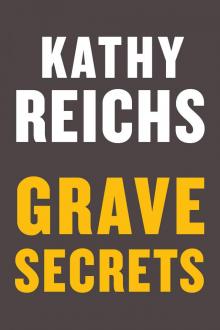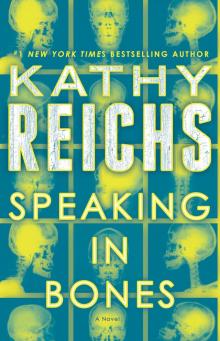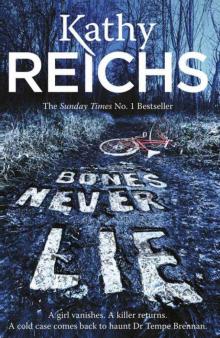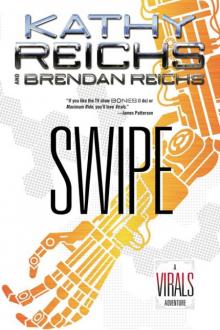- Home
- Kathy Reichs
Cross Bones Page 5
Cross Bones Read online
Page 5
I am interested in air routing between Charlotte and Montreal. I can recite the entire USAirways flight schedule. Knowing the daily direct flight had been eliminated, I was certain Jake wouldn’t arrive before midafternoon. I rolled over and went back to sleep.
A bagel and coffee around eight, and I headed to the lab. I was leaving for five days, and knew the Ferris family was anxious for information.
And for the body.
I spent another Elmer’s morning joining the dozens of segments I’d built the day before. Like assembling atoms into molecules into whole cells, I built larger and larger sections of vault.
The facial bones were a different story. Splintering was extensive, either due to the cats, or simply due to the fragile nature of the bones themselves. There would be no reconstructing the left side of Ferris’s face.
Nevertheless, a pattern emerged.
Though the lines were complex, it appeared that no break crossed the starburst radiating from the hole behind Ferris’s right ear. Fracture sequencing pointed to that wound as the entrance.
But why were the hole’s edges beveled on the outside of the skull? An entrance site should have been beveled on the inside.
I could think of one explanation, but fragments were missing from the area immediately above and to the left of the defect. To be certain, I’d need those fragments.
At two I wrote LaManche a note, explaining what I lacked. I reminded him that I was going to the annual meeting of the American Academy of Forensic Sciences in New Orleans, and that I would return to Montreal Wednesday night.
For the next two hours I ran errands. Bank. Dry cleaner. Cat chow. Birdseed. Ryan had agreed to take Birdie and Charlie, but the man has interesting views on pet care. I wanted to raise the odds in favor of proper feeding.
Jake phoned as I was driving underground into my garage. He was in the outer vestibule. Hurrying upstairs, I let him in the front door and led him down the corridor to my condo.
As we walked, I remembered the first time I’d laid eyes on Jake Drum. I was new to UNCC, and had met few faculty members outside my discipline. None from the Department of Religious Studies. Jake appeared in my lab late one evening, at a time when assaults on female students had caused security announcements to be broadcast campus-wide.
I was nervous as a mouse staring across a tank at an underweight python.
My fears were ungrounded. Jake had a question concerning bone preservation.
“Tea?” I offered now.
“You bet. I got pretzels and Sprite on the plane.”
“The dishes are behind you.”
I watched Jake select mugs, thinking what a terrible perp he’d make. His nose is thin and prominent, his brows bushy and dead straight above Rasputin black eyes. He stands six feet six, weighs 170, and shaves his head.
Witnesses would remember Jake exactly as he is.
Today I suspected he’d caused strangers on the sidewalk to circle wide. His agitation was palpable.
We exchanged small talk while waiting for the kettle.
Jake had checked into a small hotel off the western edge of the McGill University campus. He’d rented a car to drive to Toronto the next morning. On Monday he’d leave for Jerusalem, where he and his Israeli crew would excavate their first-century synagogue.
Jake proffered his usual invitation to dig. I proffered my usual thanks and regrets.
When the tea was ready, Jake settled at the dining room table. I retrieved a magnifier and Kessler’s print and laid them on the glass.
Jake stared at the photo as though he’d never seen one before.
After a full minute, he took up the lens. As he scanned the print his movements grew measured and deliberate.
In one way Jake and I are very much alike.
When annoyed, I grow churlish, snap, counter with sarcasm. When angry, truly white-hot livid irate, I go deadly calm.
So does Jake. I know. I’ve heard him debate issues at faculty council.
The ice facade is also my response to fear. I suspected this was also true of Jake. The change in his demeanor sent a chill scurrying through my mind.
“What is it?” I asked.
Jake raised his head and stared past me, lost, I could only guess, in a moment of probes, and trowels, and the smell of turned earth.
Then he tapped the photo with one long, slender finger.
A disjointed thought. Were it not for the calluses, Jake’s hands might have been those of a concert pianist.
“Have you spoken with the man who gave this to you?”
“Only briefly. We’re trying to locate him.”
“What exactly did he say?”
I hesitated, debating what I could ethically divulge. Ferris’s death had been reported by the media. Kessler had not asked for confidentiality.
I explained the shooting, the autopsy, and the man who called himself Kessler.
“It’s supposed to have come from Israel.”
“It does,” Jake said.
“That’s a hunch?”
“That’s a fact.”
I frowned. “You’re that certain?”
Jake leaned back. “What do you know about Masada?”
“It’s a peak in Israel where a lot of folks died.”
Jake’s lips did something approaching a smile.
“Please expand, Ms. Brennan.”
I dug back. Way back.
“In the first century B.C.—”
“Politically incorrect. The term is B.C.E now. Before the Common Era.”
“—the whole area from Syria to Egypt, anciently known as the land of Israel, which the Romans called Palestine, came under Roman rule. Needless to say, the Jews were pissed. Over the next century, a number of rebellions arose to throw the Roman bastards out. Each was a bust.”
“I’ve never heard it put in quite those terms. Go on.”
“About sixty-six A.D., sorry, C.E., yet another Jewish revolt steamrolled across the region. This one scared the sandals off the Romans, and the emperor deployed troops to suppress the insurgents.”
I tunneled deep for dates.
“About five years into the revolt the Roman general Vespasian conquered Jerusalem, sacked the temple, and routed the survivors.”
“And Masada?”
“Masada’s a giant rock in the Judean desert. At the start of the war a group of Jewish zealots hiked it to the top and hunkered in. The Roman general— I’m blanking on the name.”
“Flavius Silva.”
“That’s the guy. Silva was not amused. Masada was a pocket of defiance he would not tolerate. Silva set up perimeter camps, constructed an encircling wall, then an enormous ramp up the side of Masada. When his troops finally rolled a battering ram up the incline and breached the fortress, they found everyone dead.”
I didn’t mention my source, but I remembered all this from an early-eighties miniseries on Masada. Peter O’Toole as Silva?
“Excellent. Though your telling lacks a certain sense of scale. Silva didn’t just march a few platoons to Masada. His operation was massive, including his entire Tenth Legion, its auxiliary troops, and thousands of Jewish prisoners of war. Silva didn’t intend to leave until the rebels were subjugated.”
“Who was in charge up top?”
“Eleazar ben Ya’ir. The Jews had been up there seven years, and were as committed to staying as Silva was to ousting them.”
More miniseries memory bytes. Decades earlier, Herod had been into major development at Masada, ordering a casement wall around the top, defense towers, storehouses, barracks, arsenals, and a cistern system for catching and storing rainwater. Seventy years after the old king’s death, the warehouses were still stocked, and the zealots had everything they needed.
“The main source on Masada is Flavius Josephus,” Jake went on. “Joseph ben Matatyahu, in Hebrew. At the beginning of the sixty-six revolt, Josephus was serving as a Jewish commander in Galilee. Later he went over to the Romans. Regardless of his loyalties or dislo
yalties, the guy was a brilliant historian.”
“And the only reporter in town at the time.”
“There is that. But Josephus’ descriptions are amazingly detailed. According to his account, the night the fortress was breached, Eleazar ben Ya’ir gathered his followers.”
Jake leaned forward and set the scene.
“Picture this. The wall was burning. The Romans would pour in at dawn. There was no hope of escape. Ben Ya’ir argued that a death of glory was preferable to a life of slavery. Lots were cast, and ten men were elected to kill all the others. Another set of lots determined who among the ten would kill his fellow assassins, and, finally, himself.”
“There were no dissenters?”
“If so, those opinions were overruled. Two women and several children did hide out and survive. Most of Josephus’ information came from them.”
“How many died?”
“Nine hundred and sixty men, women, and children,” Jake said, his voice soft. “Jews view Masada as one of the most dramatic episodes in their history. Especially Israeli Jews.”
“What does Masada have to do with Kessler’s photo?”
“The fate of the remains of the Jewish zealots has always been a mystery. According to Josephus, Silva established a garrison on the summit immediately after Masada’s conquest.”
“Surely Masada has been excavated.”
“For years, every digger on the planet was drooling for a permit. An Israeli archaeologist named Yigael Yadin finally got the nod. Yadin worked for two field seasons using a team of volunteers. The first lasted from October of sixty-three until May of sixty-four, the second from November of sixty-four until April of sixty-five.”
I had my first inkling where Jake was going.
“Yadin’s team recovered human remains?”
“Three skeletons. On the lower terrace of Herod’s palace villa.”
“Palace villa?”
“The periodic uprisings kept the old boy nervous, so he fortified Masada as a sort of safe house should he and his family ever need to escape. And Herod wasn’t into discomfort. In addition to the wall and defensive towers, he commissioned palaces complete with colonnades, mosaics, frescoes, terraces, gardens, the whole nine yards.”
I pointed to the photo. “This is one of the three?”
Jake shook his head. “According to Yadin, one was the skeleton of a male in his twenties. Not far away lay the bones of a young woman, her sandals and scalp perfectly preserved. I’m not kidding. I’ve seen the pictures. The woman’s hair looked like she’d braided it the morning she was unearthed.”
“Aridity makes for great preservation.”
“Yes. Though the remains weren’t exactly as Yadin interpreted them.”
“What do you mean?”
“It’s not important. According to Yadin, the third skeleton was that of a child.”
“What about this guy?” Again, I pointed at Kessler’s photo.
“This guy.” Jake’s jaw muscles bunched, relaxed. “This guy wasn’t supposed to be up there at all.”
6
“NOT SUPPOSED TO BE UP THERE?”
“That’s my theory.”
“Anyone share it?”
“Some.”
“Who is he?”
“That’s the puzzler.”
I sat back and assumed a listening posture.
“Following their victory, Silva’s troops would have thrown the zealots’ bodies over the cliffs, or buried the corpses communally somewhere on the summit. Yadin’s team dug some test trenches, but found no evidence of a mass grave. Wait a sec.”
Jake pulled two items from a battered leather briefcase, and placed them on the table. The first was a map.
I scooted my chair close and we both leaned in.
“Masada is shaped like a Stealth aircraft, with one wing pointing north, the other pointing south, and the cockpit pointing west.”
My mind Rorschach-ed an amoeba, but I kept it to myself.
Jake indicated the upper edge of the summit, near the tip of his Stealth’s southern wing.
“There’s a network of caves here, a few yards below the casement wall.”
Jake slid the second item from under the map.
Old black-and-white print. Human bones. Boot-scuffed dirt.
Kessler déjà vu.
But not quite.
In this photo the bones of many people were scattered and jumbled. Also, this shot had an official north arrow/scale marker, and, in the upper right corner, an arm and knee could be seen as an excavator brushed something lying in the dirt.
“Yadin’s team found skeletal remains in one of the southern summit caves,” I guessed, not taking my eyes from the print. “This shot was taken during excavation.”
“Yes.” Jake indicated a spot on the Masada diagram. “The locus was designated Cave 2001. Yadin mentions it in his preliminary report on the Masada project, and includes a brief description by Yoram Tsafrir, the supervising excavator of the locus.”
“Minimum number of individuals in the cave?” I asked, counting at least five skulls.
“Depends on how you read Yadin.”
I looked up, surprised. “MNI shouldn’t be that tough to determine. Did a physical anthropologist examine the bones?”
“Dr. Nicu Haas of Hebrew University. Based on Haas’s evaluation, in his first field season report, Yadin gave a total of twenty-five individuals: fourteen males, six females, four children, and one fetus. But, if you read his wording carefully, he treated one very old male as separate from the other males.”
“Bringing his actual total to twenty-six.”
“Exactly. In his popular book—”
“The one that came out in sixty-six?”
“Right. Masada: Herod’s Fortress and the Zealots’ Last Stand. In that publication, Yadin does basically the same thing, saying Haas found fourteen males aged twenty-two to sixty, one male over seventy, six females, four kids, and a fetus.”
“So it’s unclear whether the total count was twenty-five or twenty-six?”
“You’re quick.”
“Blistering. Could be an honest error.”
“It could be.” Jake’s voice suggested he didn’t believe it.
“Ages of the women and children?”
“The kids were eight to twelve years. The women were all young, fifteen to twenty-two.”
Sudden insight. “You think our fellow here is the septuagenarian?” I tapped Kessler’s photo.
“I’ll get to him in a minute. For now, let me focus on the cave. In their reports, neither Tsafrir nor Yadin indicated when Cave 2001 was discovered or when it was cleared.”
“Could be just sloppy—”
He cut me off.
“The find was never announced to the media.”
“Perhaps that was done out of respect for the dead.”
“Yadin called a press conference when the three palace skeletons were found.” Jake shook his hands, fingers splayed like E.T. “Big excitement. We’ve got remains of the Jewish defenders of Masada. This was late November of sixty-three. Cave 2001 was discovered and cleared in October of sixty-three, one month before that press conference.”
Jake’s index finger augured into the photo.
“Yadin knew about the cave bones and never brought them up.”
“If the dates weren’t made public, how do you know when the cave was discovered or excavated?”
“I’ve spoken with a volunteer who worked the site. The guy’s trustworthy, and he’d have no reason to lie. And believe me, I’ve researched the media coverage. It wasn’t just that press conference. Throughout both dig seasons the media reported regularly on what was being found at Masada. The Jerusalem Post keeps topical archives, and I’ve spent hours with their Masada file. Articles mention mosaics, scrolls, the synagogue, the mikvehs, the three skeletons from the northern palace. There’s not a single word on the remains from Cave 2001.”
Jake was on a roll.
“And
I’m not just talking the Post. In October of sixty-four the Illustrated London News published an extensive spread on Masada, pictures and all. The palace skeletons are mentioned, no respect for the dead there, but there’s zilch on the cave bones.”
Charlie chose that moment to yodel.
“What the hell is that?”
“My cockatiel. He doesn’t usually do that unless you give him beer.”
“You’re kidding.” Jake sounded shocked.
“Of course.” I stood and gathered our mugs. “Charlie gets quite maudlin when he drinks. More tea?”
Jake smiled and held out his mug. “Please.”
When I returned, Jake was working a kink from his neck. I thought of a goose.
“Let me get this straight,” I said. “Yadin talked freely about the palace skeletons, but never once discussed the cave bones publicly?”
“The only mention I’ve ever found of Cave 2001 is in coverage of Yadin’s press conference following the second season’s excavation. In the Jerusalem Post on March 28, 1965, Yadin is quoted as lamenting that only twenty-eight skeletons had been found at Masada.”
“Twenty-five from the cave, and three from the northern palace.”
“If it was twenty-five.”
I rolled that around in my head.
“Who did Yadin think these cave burials were?”
“Jewish zealots.”
“Based on what?”
“Two things. Associated artifacts, and similarity of the skulls to a type unearthed in the Bar Kochba caves in Nahal Hever. At the time, those burials were thought to be Jews killed in the second Jewish revolt against Rome.”
“Were they?”
“Turned out the bones were Chalcolithic.”
Mental Rolodex. Chalcolithic. Stone and copper tools. Fourth millennium B.C.E., after the Neolithic, before the Bronze Age. Way too early for Masada.
“Physical anthropologists hold little confidence in skull typing,” I said.
“I know. But that was Haas’s conclusion, and Yadin accepted it.”
There was a long, thoughtful silence. I broke it.
“Where are the bones now?”
“Allegedly, everyone’s back in the ground at Masada.”
“Allegedly?”

 Two Nights
Two Nights The Bone Collection: Four Novellas
The Bone Collection: Four Novellas Fatal Voyage
Fatal Voyage 206 Bones
206 Bones Bones to Ashes
Bones to Ashes Terminal
Terminal Monday Mourning
Monday Mourning Flash and Bones
Flash and Bones Cross Bones
Cross Bones Devil Bones
Devil Bones Break No Bones
Break No Bones Swamp Bones
Swamp Bones Déjà Dead
Déjà Dead Shock
Shock Spider Bones
Spider Bones Death Du Jour
Death Du Jour Grave Secrets
Grave Secrets Trace Evidence: A Virals Short Story Collection
Trace Evidence: A Virals Short Story Collection Bones on Ice
Bones on Ice The Bone Code
The Bone Code Bones in Her Pocket
Bones in Her Pocket Seizure:
Seizure: Speaking in Bones
Speaking in Bones Deadly Decisions
Deadly Decisions Spike
Spike Bones Never Lie
Bones Never Lie Bones of the Lost
Bones of the Lost Virals 03.5 - Swipe
Virals 03.5 - Swipe Exposure
Exposure A Conspiracy of Bones
A Conspiracy of Bones Shift (tory brennan)
Shift (tory brennan) Bones of the Lost: A Temperance Brennan Novel tb-16
Bones of the Lost: A Temperance Brennan Novel tb-16 Virals tb-1
Virals tb-1 Bones Are Forever tb-15
Bones Are Forever tb-15 Code tb-3
Code tb-3 Seizure tb-2
Seizure tb-2 Deadly Descisions
Deadly Descisions Spider Bones: A Novel
Spider Bones: A Novel